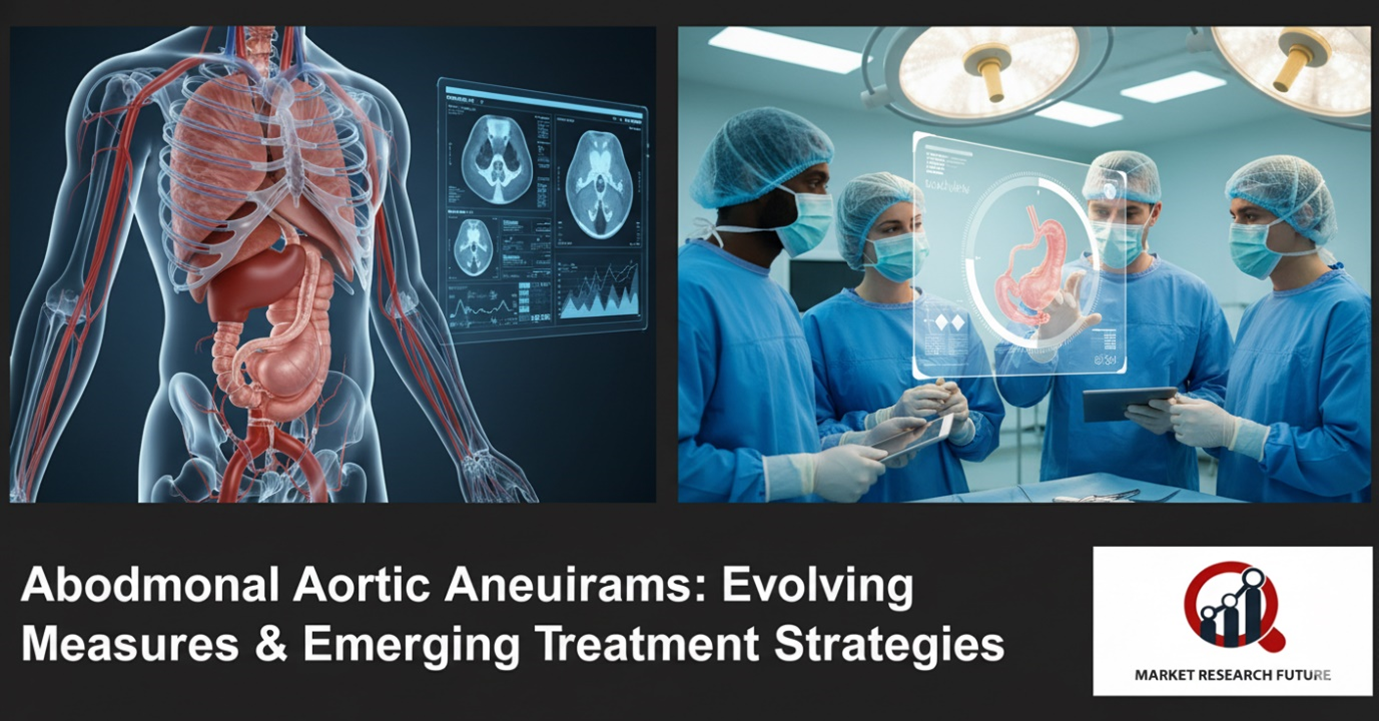Abdominal Aortic Aneurysms: Measuring and Enhancing Treatment Solutions
Abdominal Aortic Aneurysms: Evolving Measures & Emerging Treatment Strategies

Abdominal Aortic Aneurysms (AAAs) remain one of the most dangerous vascular conditions. An aneurysm of the abdominal aorta may remain asymptomatic but may result in rupture with a 90% mortality. There is a paradigm shift in the detection, risk stratification, and treatment of AAAs owing to advances in imaging, interventional techniques, and more.
Pathophysiology and Risk Factors: What Drives AAA Formation & Growth
Anatomical & Cellular Mechanisms
- AAA is classically defined as a focal enlargement of the abdominal aorta (often infrarenal) to ≥ 1.5× the normal diameter or > 3.0 cm.
- The hallmarks include degradation of the extracellular matrix (especially elastin), loss or dysfunction of vascular smooth muscle cells (VSMCs), inflammation, protease overexpression (notably matrix metalloproteinases MMP-2, MMP-9), oxidative stress, and a sustained remodeling (dilation) response.
- Intraluminal thrombus (ILT) often lines the inner wall of the aneurysm, which contributes to local hypoxia, inflammation, and proteolytic activity.
- Hemodynamic factors (wall stress, shear stress), vascular wall strain, and biomechanical heterogeneity modulate which regions of the wall are prone to further dilation or rupture.
AAA Rupture Risk Assessment
- AAAs may present as fusiform (circumferential dilation of the aortic segment) or saccular (localized pouch), with fusiform being the more common type.
- Ripening ruptures of unesthetic AAAs are classically associated with the maximal aortic diameter coupled with growth (increase in aortic diameter). Although there are simple metrics that assess the rate of cross-sectional diameter growth and maximal diameter to quantify the potential rupture risk, classically, aortic rupture risk has only been associated with growth rate and maximal diameter. Most aortic segments of the same diameter (circumference) have markedly dissimilar pressure gradients and different rupture thresholds.
- Recent research strives to quantify wall strain, wall rupture potential, redundancy (auto) structural indices and biomechanical rupture potential risk with advanced imaging and computational models. For example, the Relative Structural Integrity Index (RSII) uses a high level of integrated geometric modelling with a wall strain measurement and tension vector (bending) analysis to assess rupture potential.
- Another recent effort uses geometric deep learning to analyze AAA surfaces and predict local growth over time with a high degree of accuracy (median error ~1.18 mm).
- Consequently, the “diameter-only” approach is being shifted with more focus being placed on wall stress, strain, and weakening, as the new standard onboarding approach.
Clinical Presentation and Diagnostic Tool
Clinical Features
- The majority of AAAs are asymptomatic until the critical phase of rupture and dissection occurs.
- When symptoms occur, it is associated with posterior, abdominal, or flank pain, a pulsatile abdominal mass, or pain in the groin and legs due to extension.
- In the presence of a small leak or impending rupture, the crescent sign (high attenuation crescent on CT, hemorrhage into the mural thrombus) is present and is considered a significant indicator of concern radiologically.
- Signs of rupture are rare, but they include ecchymosis due to retroperitoneal bleeding, hypotension, syncope, abdominal distension, and shock.
Diagnostic Imaging & Risk Stratification
- Computed Tomography Angiography (CTA): captures critical 3D reconstructions for procedural planning, revealing the morphology and the calcified aspects of the walls, the thrombus burden, and the 3D reconstructions that are fundamental for procedural planning.
- Biomarkers/ molecular imaging: preclinical and very early-stage investigations are assessing PET and molecular tracers for inflammation and protease activity, although these remain non-standard.
- Computational modeling/ Finite Element Analysis (FEA): the integration of geometry, wall properties, and pressure loads to assess wall stress and risk of rupture. Accuracy is hindered by uncertainties surrounding wall thickness, material properties, and segmentation. One recent study looked at the influence of geometric uncertainty on computed strain and found that inward biases in geometry impact strain accuracy more dramatically than outward biases.
Treatment Paradigms: From Watchful Waiting to Regeneration
Surveillance & Medical Management
- The approach of watchful waiting, or monitoring, is appropriate for small (5.0–5.5 cm) AAAs or for those aneurysms that do not grow rapidly. Growth is tracked using interval imaging performed annually or semi-annually.
- Numerous classes of medications (for example, doxycycline, rapamycin, or ACE inhibitors) have been considered for this purpose, yet none have demonstrated clear clinical benefit in human studies.
- There is growing interest in drug repurposing (for example, metformin and statins) to reduce AAA expansion. Meta-analyses suggest small effects, but there is a paucity of confirmatory studies.
Indications for Intervention
- Elective repair is generally performed when the maximal diameter is over approximately 5.5 cm for men or over 5.0 cm for women, or the aneurysm is growing more than 0.5 cm/year or when symptoms arise.
- For saccular AAAs, the intervention threshold may be lower due to the perception of a higher risk of rupture, although definitive evidence is scarce and there is variability in clinical practice.
- Also, in the case of the described high-risk aneurysm morphology in imaging (e.g., crescent sign, penetrating ulcer, asymmetric stress distribution, or other delineating factors), repair may be warranted at even smaller diameters.
Anticipated Developments
- More comprehensive personalized risk assessments that synthesize morphological, mechanical, and biological elements, including advanced strain mapping, RSII, and machine-learning growth predictions.
- The implementation of rapid surrogate models that utilize neural networks in place of computational fluid dynamics renders real-time hemodynamic assessments clinically practicable.
- The development of hybrid repair and regeneration strategies that incorporate interventional scaffolds designed not only to exclude aneurysms but also to provide stabilizing and regenerative agents.
- Advanced disruption in strengthening segment detection, driven by inflammatory, proteolytic, and microstructural imaging tracers, weak segment identification, and unmasking underpinning degeneration.
- The initiation of clinical trials incorporating drug therapies or biologics designed to slow or reverse AAA progression in patients who are unfit or undecided for surgery.
- More detailed and flexible guidelines and decision-making frameworks incorporating advanced biomechanical and imaging risk for repair, incorporating imaging-derived thresholds that move away from rigid diameter cutoffs.

Leave a Comment